#Cheap Electronic Components
Explore tagged Tumblr posts
Text
Semikart - The Premier Marketplace for Electronic Components in India
Semikart is India's first dedicated online marketplace that streamlines the search and purchase of electronic components. With a diverse catalog of over 8 million products sourced from more than 5,000 global manufacturers, Semikart serves as a one-stop shop for electronic components, semiconductors, microcontrollers, and connectors. It caters primarily to value-added distributors and simplifies the procurement process by allowing users to browse inventories from multiple suppliers and integrating purchases into a single order, thereby transforming the electronic component sourcing landscape in India.
#Electronic parts distributor#Electronic components distributor#Electronic component suppliers#Buy online electronics components#distributor for electronic components#cheap electronic components
2 notes
·
View notes
Text
Key Benefits of Partnering with NXP Diodes and Electronic Connectors Distributors
Partnering with trusted distributors for NXP diodes, electronic connectors, TE Connectivity relays, and Freescale components ensures reliable access to genuine parts. With expert support, comprehensive product ranges, and timely delivery, these partnerships enhance efficiency and streamline your projects.
1 note
·
View note
Text
fucked up that diodes are one of the cheapest electronic components you can buy when the way the work is basically magic
#they're so cheap! 1n4148 is the only component that I buy in quantities of 1000#synths#synth diy#electronics
2 notes
·
View notes
Note
Is AWAY using it's own program or is this just a voluntary list of guidelines for people using programs like DALL-E? How does AWAY address the environmental concerns of how the companies making those AI programs conduct themselves (energy consumption, exploiting impoverished areas for cheap electricity, destruction of the environment to rapidly build and get the components for data centers etc.)? Are members of AWAY encouraged to contact their gov representatives about IP theft by AI apps?
What is AWAY and how does it work?
AWAY does not "use its own program" in the software sense—rather, we're a diverse collective of ~1000 members that each have their own varying workflows and approaches to art. While some members do use AI as one tool among many, most of the people in the server are actually traditional artists who don't use AI at all, yet are still interested in ethical approaches to new technologies.
Our code of ethics is a set of voluntary guidelines that members agree to follow upon joining. These emphasize ethical AI approaches, (preferably open-source models that can run locally), respecting artists who oppose AI by not training styles on their art, and refusing to use AI to undercut other artists or work for corporations that similarly exploit creative labor.
Environmental Impact in Context
It's important to place environmental concerns about AI in the context of our broader extractive, industrialized society, where there are virtually no "clean" solutions:
The water usage figures for AI data centers (200-740 million liters annually) represent roughly 0.00013% of total U.S. water usage. This is a small fraction compared to industrial agriculture or manufacturing—for example, golf course irrigation alone in the U.S. consumes approximately 2.08 billion gallons of water per day, or about 7.87 trillion liters annually. This makes AI's water usage about 0.01% of just golf course irrigation.
Looking into individual usage, the average American consumes about 26.8 kg of beef annually, which takes around 1,608 megajoules (MJ) of energy to produce. Making 10 ChatGPT queries daily for an entire year (3,650 queries) consumes just 38.1 MJ—about 42 times less energy than eating beef. In fact, a single quarter-pound beef patty takes 651 times more energy to produce than a single AI query.
Overall, power usage specific to AI represents just 4% of total data center power consumption, which itself is a small fraction of global energy usage. Current annual energy usage for data centers is roughly 9-15 TWh globally—comparable to producing a relatively small number of vehicles.
The consumer environmentalism narrative around technology often ignores how imperial exploitation pushes environmental costs onto the Global South. The rare earth minerals needed for computing hardware, the cheap labor for manufacturing, and the toxic waste from electronics disposal disproportionately burden developing nations, while the benefits flow largely to wealthy countries.
While this pattern isn't unique to AI, it is fundamental to our global economic structure. The focus on individual consumer choices (like whether or not one should use AI, for art or otherwise,) distracts from the much larger systemic issues of imperialism, extractive capitalism, and global inequality that drive environmental degradation at a massive scale.
They are not going to stop building the data centers, and they weren't going to even if AI never got invented.
Creative Tools and Environmental Impact
In actuality, all creative practices have some sort of environmental impact in an industrialized society:
Digital art software (such as Photoshop, Blender, etc) generally uses 60-300 watts per hour depending on your computer's specifications. This is typically more energy than dozens, if not hundreds, of AI image generations (maybe even thousands if you are using a particularly low-quality one).
Traditional art supplies rely on similar if not worse scales of resource extraction, chemical processing, and global supply chains, all of which come with their own environmental impact.
Paint production requires roughly thirteen gallons of water to manufacture one gallon of paint.
Many oil paints contain toxic heavy metals and solvents, which have the potential to contaminate ground water.
Synthetic brushes are made from petroleum-based plastics that take centuries to decompose.
That being said, the point of this section isn't to deflect criticism of AI by criticizing other art forms. Rather, it's important to recognize that we live in a society where virtually all artistic avenues have environmental costs. Focusing exclusively on the newest technologies while ignoring the environmental costs of pre-existing tools and practices doesn't help to solve any of the issues with our current or future waste.
The largest environmental problems come not from individual creative choices, but rather from industrial-scale systems, such as:
Industrial manufacturing (responsible for roughly 22% of global emissions)
Industrial agriculture (responsible for roughly 24% of global emissions)
Transportation and logistics networks (responsible for roughly 14% of global emissions)
Making changes on an individual scale, while meaningful on a personal level, can't address systemic issues without broader policy changes and overall restructuring of global economic systems.
Intellectual Property Considerations
AWAY doesn't encourage members to contact government representatives about "IP theft" for multiple reasons:
We acknowledge that copyright law overwhelmingly serves corporate interests rather than individual creators
Creating new "learning rights" or "style rights" would further empower large corporations while harming individual artists and fan creators
Many AWAY members live outside the United States, many of which having been directly damaged by the US, and thus understand that intellectual property regimes are often tools of imperial control that benefit wealthy nations
Instead, we emphasize respect for artists who are protective of their work and style. Our guidelines explicitly prohibit imitating the style of artists who have voiced their distaste for AI, working on an opt-in model that encourages traditional artists to give and subsequently revoke permissions if they see fit. This approach is about respect, not legal enforcement. We are not a pro-copyright group.
In Conclusion
AWAY aims to cultivate thoughtful, ethical engagement with new technologies, while also holding respect for creative communities outside of itself. As a collective, we recognize that real environmental solutions require addressing concepts such as imperial exploitation, extractive capitalism, and corporate power—not just focusing on individual consumer choices, which do little to change the current state of the world we live in.
When discussing environmental impacts, it's important to keep perspective on a relative scale, and to avoid ignoring major issues in favor of smaller ones. We promote balanced discussions based in concrete fact, with the belief that they can lead to meaningful solutions, rather than misplaced outrage that ultimately serves to maintain the status quo.
If this resonates with you, please feel free to join our discord. :)
Works Cited:
USGS Water Use Data: https://www.usgs.gov/mission-areas/water-resources/science/water-use-united-states
Golf Course Superintendents Association of America water usage report: https://www.gcsaa.org/resources/research/golf-course-environmental-profile
Equinix data center water sustainability report: https://www.equinix.com/resources/infopapers/corporate-sustainability-report
Environmental Working Group's Meat Eater's Guide (beef energy calculations): https://www.ewg.org/meateatersguide/
Hugging Face AI energy consumption study: https://huggingface.co/blog/carbon-footprint
International Energy Agency report on data centers: https://www.iea.org/reports/data-centres-and-data-transmission-networks
Goldman Sachs "Generational Growth" report on AI power demand: https://www.goldmansachs.com/intelligence/pages/gs-research/generational-growth-ai-data-centers-and-the-coming-us-power-surge/report.pdf
Artists Network's guide to eco-friendly art practices: https://www.artistsnetwork.com/art-business/how-to-be-an-eco-friendly-artist/
The Earth Chronicles' analysis of art materials: https://earthchronicles.org/artists-ironically-paint-nature-with-harmful-materials/
Natural Earth Paint's environmental impact report: https://naturalearthpaint.com/pages/environmental-impact
Our World in Data's global emissions by sector: https://ourworldindata.org/emissions-by-sector
"The High Cost of High Tech" report on electronics manufacturing: https://goodelectronics.org/the-high-cost-of-high-tech/
"Unearthing the Dirty Secrets of the Clean Energy Transition" (on rare earth mineral mining): https://www.theguardian.com/environment/2023/apr/18/clean-energy-dirty-mining-indigenous-communities-climate-crisis
Electronic Frontier Foundation's position paper on AI and copyright: https://www.eff.org/wp/ai-and-copyright
Creative Commons research on enabling better sharing: https://creativecommons.org/2023/04/24/ai-and-creativity/
217 notes
·
View notes
Text
The guitar is in fact a Yamaha and not a Landola. Anyway, I got the finest €13.90 nylon strings money can buy. The electronics/music shop that I got them from is great. They have like every electronic component ever invented, all kinds of miscellaneous doodads and gubbins no one has ever heard about and everything is dirt cheap.
6 notes
·
View notes
Text


Someone was having trouble getting decent sound in his living room and instead of recommending a room treatment or better speakers this person just casually suggests PUTTING AN ADDITION ONTO THE HOUSE.
Trying to get advice on audio forums is often a challenge because a lot of these dudes just have *so much* disposable income. And they just assume everyone else is wealthy too. You can even tell them you have a budget and they'll be like, "You should save up longer and buy this thing that is three times your budget."
And it's not like there aren't wonderful options that are more affordable. I think I may have about $3000 worth of home theater equipment that I have collected over the last 20 years. They will spend that on a single speaker and suggest you do the same.
The people in these forums would have a fit if they knew I had a single subwoofer. Apparently, the cardinal audio sin is having only ONE subwoofer.
Your room could have NULLS!
NULLLLLLS!!!
Seriously, they will lecture you anytime you mention having a single subwoofer. "Your seat-to-seat response is going to be inconsistent!"
I also saw a guy say that a 15" subwoofer was "tiny" and "pointless."
My 70-pound, 12" subwoofer is currently vibrating items off the shelf in my house ever since I moved it upstairs and don't have concrete floors like in the basement. I'm going to have to buy special subwoofer feet to decouple it from the floor. I can't imagine what a 15" sub would do to my house. It might collapse on top of me.
So you can only get a sub that is at least 18" and you need a minimum of 2... but 4 is much better. Actually, 4 is the minimum. 2 is garbage. 2 in front and 2 in back.
And, of course, you have to get a Rythmik or PSA subwoofer. Don't cheap out on the brand!

You have to build an addition to the house AND buy $8000 worth of subwoofers and then MAYBE your sound will be somewhat listenable.
But only if you calibrate the subs with a MiniDSP and the proper UMIK calibration microphone.

Wait, do you have a regular AVR with built in amplification? That won't do. What you need is an audio processor with individual external amplification.

You'll need a 9.4.6 configuration for the proper surround sound experience. That is 9 ear-level speakers, 4 subwoofers, and 6 atmos ceiling speakers.
So 2 of these.

1 of these.

3 pairs of these.

6 of these... plus professional ceiling installation.

And an individual amplifier for each speaker.
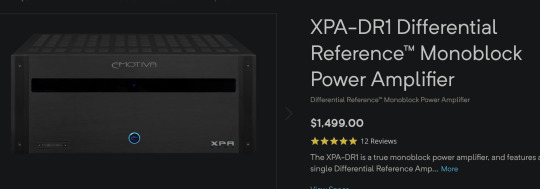
Do you really need a 600 watt amp for the ceiling speakers too?
OF COURSE YOU DO!
DO YOU WANT A LOW NOISE FLOOR AND NO DISTORTION OR DO YOU WANT GARBAGE?
Comfort is important too. So you'll want a Valencia leather power recliner with LED cup holder.

And... by far... the most important home theater component...
The power cable.
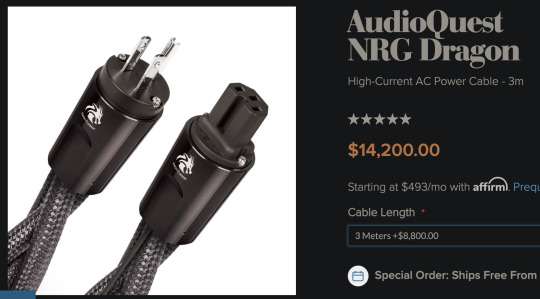
This will assure that only the highest quality electrons are delivered to your audio equipment.
Don't think about it too much.
Don't think about all of the janky powerlines that deliver electricity to your house.
Or all of the generic power cables inside your wall.
This cable magically negates all of that and turns the last few feet of electricity into pure, audio-grade power.
Guaranteed to drastically improve your sound quality... somehow.
It can't be nonsense, otherwise someone would have never written such beautiful prose about a power cable in a review...
"I was smitten by the piano’s extra depth in its nether regions. I’m not talking about what some audiophiles like to refer to as testicular bass, but rather, a rich and absorbing presentation."
$14,000 for rich and absorbing testicular bass? WORTH IT!
So that's roughly $65,870 for all of that and between $50,000 and $100,000 for a 500 square foot room addition.
A small price to pay for a room that is not junk for listening to music.
202 notes
·
View notes
Text
How a Computer Works - Part 3 (Miniaturization and Standardization)
For anyone just joining in, I'm writing a series of posts explaining perhaps haphazardly all there is to know about how a computer works, from the most basic fundamental circuitry components to whatever level of higher functionality I eventually get to. As explained in the first post on this subject, I am doing this just in pure text, so that if you are inclined you can straight up print these posts out or narrate them onto some audio tape or whatever and have full access to them should every computer in the world suddenly collapse into a pile of dust or something. Part 1 mainly covered the basic mechanical principles of circuitry and how to physically construct a logic gate. Part 2 covered logic gates in detail and how to use them to create a basic working architecture for a general purpose computer. Today we're going to be talking more about what you're looking at when you crack a machine open so you can make sense of all the important fiddly bits and have maybe a starting point on how to troubleshoot things with a multimeter or something.
Before getting into it though, I do have to shake my little donation can again and remind you that I do not know how I am going to get through the winter without becoming homeless, so if this is valuable to you, I'd appreciate some help.
Boards of Bread and Printed Circuits
With the things I've explained so far, you could totally build a computer right now, but it'd be a bit messy. You can totally buy resistors, transistors, capacitors, and diodes by the bagful for basically nothing, and cheap rolls of insulated wire, but there's all these long exposed pins to cut short and soldering things in mid-air is a messy nightmare and you'd just have this big tangle of wires in a bag or something that would almost certainly short out on you. So let's look into ways to organize stuff a little.
If you start playing around with electronics on your own, one of the first things you want to hook yourself up with besides raw components and wires is a breadboard or 12. And if you're watching people explain these things with visual aids, you'll also see a lot of them, so it's good to know exactly what they are and how they work. Your standard breadboard is a brick of plastic with a bunch of little holes in it. Incidentally, the name comes from how the first ones were literally just named after the wooden cutting boards for slicing bread people recycled to make them. Inside these holes there's some pinching bits of conductive metal which connect to each other in a particular way (pretty sure you can just see the strips that connect one if you pry the bottom off), so you can just jam a thing wire or prong into a hole, have it held in place, and make a connection to every other hole its connected to on the other side.
There is a ton of standardization to all of this. The holes should always be 0.1 inches apart () and split into two big grids. Everyone I've ever seen has 63 rows, each with 5 holes labeled A-E, a shallow channel through the middle of the board, and then another 5, F-J, and we generally have numbers printed every 5 rows. Down underneath, for any given row, the set of 5 pins on each side of the channel are connected. So, holes 1A, 1B, 1C, 1D, and 1E are all connected to each other, and nothing else. Holes 1F, 1G, 1H, 1I, and 1J are also connected to each other. There's no connection though between 1E and 1F, or 1A and 2A.
Most breadboards will also have a couple of "power rails" along the sides. These are just going to be labeled with a long red line and +, and a long blue or black line and -, and have holes in 2x5 blocks staggered out. With these, all 25 or 50 or whatever holes near the red + line connect with each other, and all the ones near the black line connect with each other. The gaps every 5 holes don't serve any purpose beyond looking different enough from the big grid so you hopefully don't mix it up and forget that these ones all connect down the length, and not in in little clumps across the width like everything else. The idea, for the sake of convention, is you plug a wire connected directly to the positive side of your battery or DC adapter or whatever into any red line hole, the negative side to any blue/black hole, and then tada, you can make a circuit just by plugging a wire in from red to a normal grid line, whatever bits you want span from that grid line to another, and eventually you connect the far end back anywhere on the black/blue line.
With a nice circuit board, there's also little snap-together pegs along the sides, and the power rails are just snapped on with those. So you can just kinda cut through the backing with a knife or some scissors, snap those off, connect multiple boards together without redundant power rails in the middle, and then just have these nice spare long lines of linked sockets. In the computer I'm building on these, I'm just using spare power rails for the bus. Oh and the big grooved channel down the middle also has a purpose. Bigger electronic components, like our good good friend the integrated circuit, are generally designed to be exactly wide enough (or more, but by a multiple of 0.1 inches) to straddle that groove as you plug their legs into the wires on either side, so they nicely fit into a breadboard, and there's a handy gap to slide something under and pry them off later on.
Typically though, you don't see breadboards inside a computer, or anything else. They're super handy for tinkering around and designing stuff, but for final builds, you want something more permanent. Usually, that's a printed circuit board, or PCB. This is pretty much what everyone's going to picture when they think about the guts of a computer. A big hard (usually) green board with a bunch of intricate lines, or "traces" running all over made of (usually) copper. And maybe with some metal ringed holes punched all the way through (they call those vias). These tend to look really complicated and maybe even a little magical, but they're honestly they're just pre-placed wires with a sense of style.
Most of the material of the board is insulated. The copper traces conduct real well, and manufacturers have done the math on just how close together they can be run without connecting to each other in places you don't want. The holes that go all the way through are for either plugging other bits in that tend to come with long legs you maybe want to keep intact, or just ways to run a trace through to the other side, where we often have traces on the back too to maximize our space. Most of what makes them look all cool and magical is how the traces run as close packed as possible to conserve space, and tend to only turn at 45 degree angles, which is just an artifact of how the machinery used to etch them out sued to be iffy about anything else.
So tada, you have all your wires pre-stuck to a nice sturdy board, and maybe even have labels printed right on there for where you solder all the various components to finish the thing. Oh and when you hear people talk about like, motherboards and daughterboards? The big main board you have for everything is a motherboard. Sometimes you need more than that, so you make smaller ones, and connect them up ether with some soldering or cartridge style with end-pins sliding snugly into sockets, and those we call daughterboards.
Integrated Circuits, or as they're also known, "chips"
The last thing you're likely to find if you crack open a computer, or just about any other electronic device that isn't super old or super super simple, are integrated circuits. Generally these are think black plastic bars that look like you'd maybe try to awkardly use them to spread cheese or peanutbutter on crackers in a prepacked snack or something, with rows of tiny little legs that running along either side. Kinda makes them look like little toy bugs or something. Sometimes they're square with pins along every edge, because sometimes you need a lot of pins. These are integrated circuits, or microchips, or just chips, and wow are they handy.
Sometime back in the 60s when people were really getting their heads around just how ridiculously small they could make electronic components and still have them work, we started to quite rapidly move towards a point where the big concern was no longer "can we shrink all this stuff down to a manageable size" and more "we are shrinking everything down to such an absurdly tiny size that we need to pack it all up in some kind of basically indestructible package, while still being able to interact with it."
So, yeah, we worked out a really solid standard there. I kinda wish I could find more on how it was set or what sort of plastic was used, but you take your absurdly shrunken down complex circuit for doing whatever. You run the teensiest tiniest wires you can out from it that thicken up at the ends into standard toothy prongs you can sink into a breadboard or a PCB with that standardized pin spacing, and you coat it all in this black plastic so firmly enveloping it that nothing can move around inside or get broken, hopefully.
And honestly, in my opinion, this is all TOO standardized. The only real visible difference between any two given integrated circuits is how many legs they have, and even those tend to come to some pretty standard numbers. They're always the same size shape and color, they all have the same convention of having a little indented notch on one side so you know which end is which, and they all seem to use just the worst ink in the world to print a block of numbers on the back with their manufacturer, date of assembly, a catalog number, and some other random stuff.
For real if there's any real comprehensive standard for what's printing on these, I can't for the life of me find it. All I know is, SOMEWHERE, you've got a 2 or 3 letter code for every manufacturer, a number for the chip, and a 4 digit date code with the last 2 digits of the year, and which week of that year it was. These three things can be in any order, other things can also be on there, probably with zero spacing, and usually printed in ink that wipes away like immediately or at least is only readable under really direct light, it sucks.
Once you know what a chip is though and look up the datasheet for it, you should have all sorts of handy info on what's inside, and just need to know what every leg is for. For that, you find which end has a notch in it, that's the left side, sometimes there's also a little dot in the lower left corner, and hopefully the label is printed in alignment with that. From there, the bottom left leg is pin 1, and then you count counterclockwise around the whole chip. You're basically always going to have positive and negative power pins, past that anything goes. You can cram a whole computer into a single chip, yo can have someone just put like 4 NAND gates on a chip for convenience, whatever.
OK, but how do they make them so small?
OK, so, mostly a circuit we're going to want to shrink down and put on a chip is just gonna be a big pile of logic gates, we can make our logic gates just using transistors, and we can make transistors just by chemically treating some silicon. So we just need SUPER flat sheets of treated silicon, along with some little strands of capacitive/resistive/insulating material here and there, and a few vertically oriented bits of conductive metal to pass signals up and down as we layer these together. Then we just need to etch them out, real real small and tight.
And we can do that etching at like, basically infinite resolution it turns out. It just so happens we have access to special acids that eat through the materials we need them to eat through, but that only work when they're being directly hit with fairly intense UV light. And a thing about light is when you have say, a big cut out pattern that you hold between a light and a surface, it casts a shadow on it... and the scaling of that shadow depends entirely on the distances between the light, the pattern, and the surface. So if you're super careful calibrating everything, you can etch a pattern into something at a scale where the main limiting factors become stuff like how many molecules thick things have to be to hold their shape. Seriously, they use electron microscopes to inspect builds because that's the level of tininess we have achieved.
So yeah, you etch your layers of various materials out with shadow masks and UV acid, you stack them up, you somehow align microscopic pins to hold them together and then you coat the whole mess in plastic forever. Tada. Anything you want in a little chip.
ROMs, maybe with various letters in front
So there's a bunch of standard generally useful things people put into ICs, but also with a computer you generally want some real bespoke stored values with a lookup table where you'll keep, say, a program to be run by feeding whatever's inside out to the bus line by line. For that we use a chip we call Read Only Memory, or ROM. Nothing super special there, just... hard wire in the values you need when you manufacture it. Manufacturing these chips though is kind of a lot, with the exacting calibrations and the acid and the clean rooms and all. Can't we have some sort of Programmable ROM? Well sure, just like build it so that all the values are 1, and build a special little thing that feeds more voltage through than it can handle and physically destroy the fuse for everything you don't want to be a 1.
OK that's still kind of a serious commitment. What if I want to reuse this later? Oh, so you want some sort of Erasable PROM? OK someone came up with a funky setting where you overload and blow out the fuses but then if you expose the guts of the chip to direct UV light through this little window, everything should reform back to 1. Just like, throw a sticker on there when you don't want to erase it. Well great, but can we maybe not have me desolder it and take it out to put under a lamp? Oh la de da! You need Electronically Erasable PROMs? EEPROMs? I guess we can make THAT work, somehow. They're still gonna be slow to write to though, can't have anything. I mean, not unless we invented like, flash memory. Which somehow does all this at speeds where you can use it for long term storage without it being a pain. So that's just kinda the thing we have now. Sorry I don't quite get the principles behind it enough to summarize. Something about floating components and needing less voltage or whatever. Apparently you sacrifice some read speed next to older options but hey, usable rewritable long term storage you just plug in, no jumping through extra hoops.
So OK. I think that's everything I can explain without biting the bullet and explaining ALUs and such. Well, there's keyboards (they're just buttons connecting input lines), monitors (these days, LEDs wired up in big grids), and mice (there's spokes in wheels that click X times or cameras checking the offset values of dust on your desk or whatnot).
Maybe throw me some money before we move on ?
CONTINUED IN PART 4
#computers#computer science#pcb#printed circuit board#integrated circuits#microchip#breadboards#education#electronics
56 notes
·
View notes
Text

Next-generation sustainable electronics are doped with air
Semiconductors are the foundation of all modern electronics. Now, researchers at Linköping University, Sweden, have developed a new method where organic semiconductors can become more conductive with the help of air as a dopant. The study, published in the journal Nature, is a significant step towards future cheap and sustainable organic semiconductors. "We believe this method could significantly influence the way we dope organic semiconductors. All components are affordable, easily accessible, and potentially environmentally friendly, which is a prerequisite for future sustainable electronics," says Simone Fabiano, associate professor at Linköping University. Semiconductors based on conductive plastics instead of silicon have many potential applications. Among other things, organic semiconductors can be used in digital displays, solar cells, LEDs, sensors, implants, and for energy storage.
Read more.
18 notes
·
View notes
Text
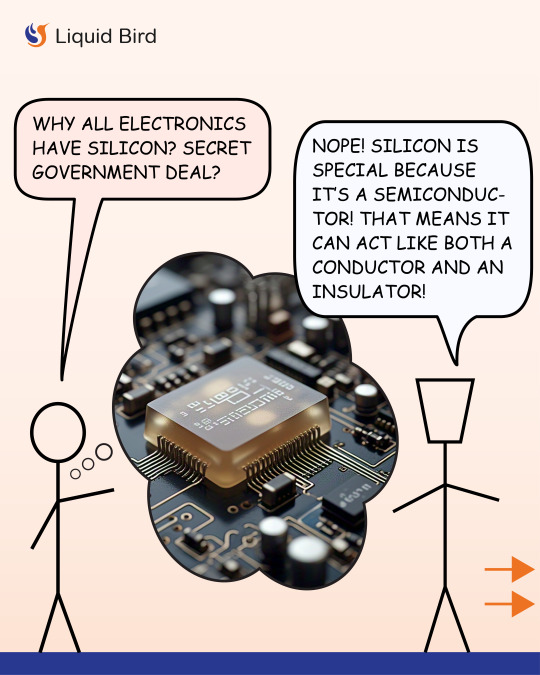
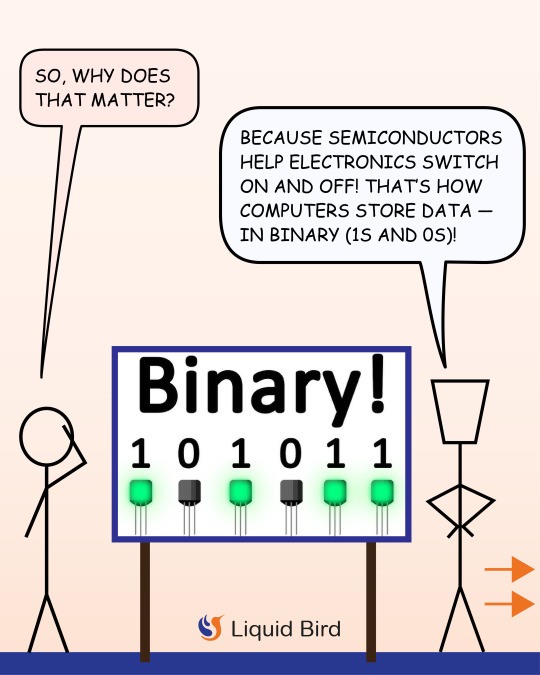

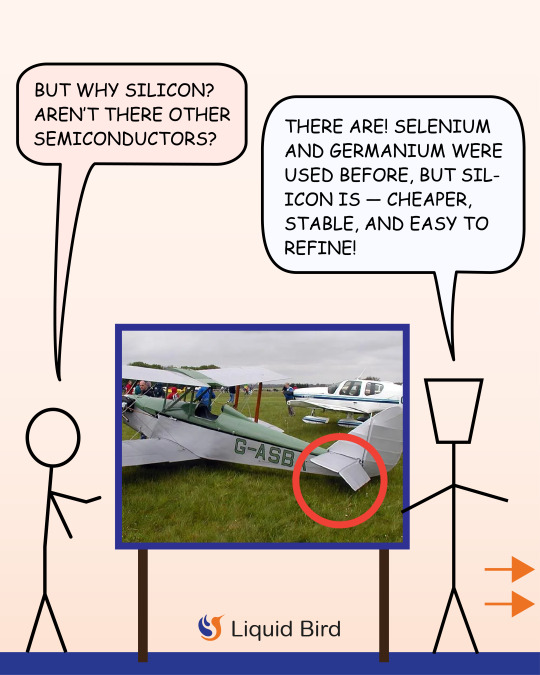


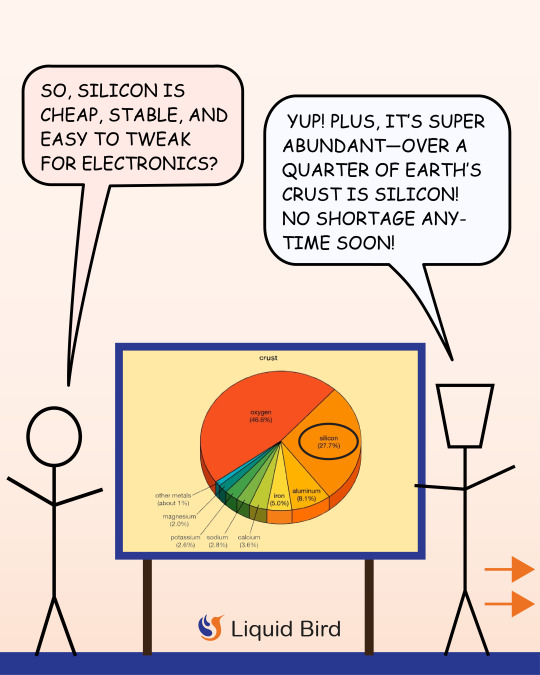



Silicon is the king of electronics, but it wasn’t always that way. In the early days, materials like germanium and selenium were used in making transistors and diodes. Germanium was great because it had high conductivity and worked well in early circuits, but it had one big problem—it couldn’t handle high temperatures. Selenium was used in rectifiers, but it wasn’t as efficient as today’s semiconductors. Then came silicon, and it changed everything.
Silicon became the top choice because it has the perfect balance of electrical properties and stability. It’s a semiconductor, meaning it can act as both a conductor and an insulator, depending on how it’s treated. This makes it ideal for transistors, microchips, and other electronic components. One major advantage is its ability to withstand high temperatures, unlike germanium, which breaks down easily when things heat up. Silicon also has a stable crystalline structure, which makes it reliable for long-term use in circuits.
Another big reason for silicon’s dominance is how easy it is to “dope.” Doping is the process of adding tiny amounts of other elements to change how silicon conducts electricity. By adding phosphorus or boron, engineers can create either n-type or p-type silicon, which are essential for making diodes, transistors, and integrated circuits. This precise control over its conductivity is what makes modern electronics possible.
On top of all that, silicon is incredibly abundant. It’s the second most common element in Earth’s crust, found in sand and quartz. This makes it cheap and easy to source compared to rarer materials. Because of this, silicon-based chips are affordable and mass-producible, making electronics available to everyone.
From the first germanium transistors to today’s advanced silicon microprocessors, technology has come a long way. And thanks to silicon, we have everything from smartphones to supercomputers.
Follow for more such educational content daily!
Check, our substack for more in-depth articles on such topics.
#comics#sciencecomics#webcomics#science#stem#educationalcomics#liquidbird#becurious#comicstrips#rockets#space#electronics#aircraft
5 notes
·
View notes
Text
The phone or computer you’re reading this on may not be long for this world. Maybe you’ll drop it in water, or your dog will make a chew toy of it, or it’ll reach obsolescence. If you can’t repair it and have to discard it, the device will become e-waste, joining an alarmingly large mountain of defunct TVs, refrigerators, washing machines, cameras, routers, electric toothbrushes, headphones. This is “electrical and electronic equipment,” aka EEE—anything with a plug or battery. It’s increasingly out of control.
As economies develop and the consumerist lifestyle spreads around the world, e-waste has turned into a full-blown environmental crisis. People living in high-income countries own, on average, 109 EEE devices per capita, while those in low-income nations have just four. A new UN report finds that in 2022, humanity churned out 137 billion pounds of e-waste—more than 17 pounds for every person on Earth—and recycled less than a quarter of it.
That also represents about $62 billion worth of recoverable materials, like iron, copper, and gold, hitting e-waste landfills each year. At this pace, e-waste will grow by 33 percent by 2030, while the recycling rate could decline to 20 percent. (You can see this growth in the graph below: purple is EEE on the market, black is e-waste, and green is what gets recycled.)

“What was really alarming to me is that the speed at which this is growing is much quicker than the speed that e-waste is properly collected and recycled,” says Kees Baldé, a senior scientific specialist at the United Nations Institute for Training and Research and lead author of the report. “We just consume way too much, and we dispose of things way too quickly. We buy things we may not even need, because it's just very cheap. And also these products are not designed to be repaired.”
Humanity has to quickly bump up those recycling rates, the report stresses. In the first pie chart below, you can see the significant amount of metals we could be saving, mostly iron (chemical symbol Fe, in light gray), along with aluminum (Al, in dark gray), copper (Cu), and nickel (Ni). Other EEE metals include zinc, tin, and antimony. Overall, the report found that in 2022, generated e-waste contained 68 billion pounds of metal.
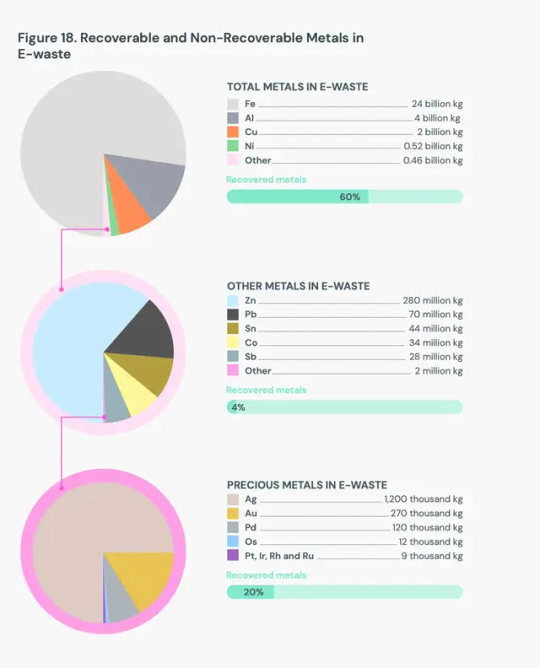
E-waste is a complex thing to break down: A washing machine is made of totally different components than a TV. And even for product categories, not only do different brands use different manufacturing processes, but even different models within those brands vary significantly. A new washing machine has way more sensors and other electronics than one built 30 years ago.
Complicating matters even further, e-waste can contain hazardous materials, like cobalt, flame retardants, and lead. The report found that each year, improperly processed e-waste releases more than 125,000 pounds of mercury alone, imperiling the health of humans and other animals. “Electronic waste is an extremely complex waste stream,” says Vanessa Gray, head of the Environment and Emergency Telecommunications Division at the UN’s International Telecommunication Union and an author of the report. “You have a lot of value in electronic waste, but you also have a lot of toxic materials that are dangerous to the environment.”
That makes recycling e-waste a dangerous occupation. In low- and middle-income countries, informal e-waste recyclers might go door-to-door collecting the stuff. To extract valuable metals, they melt down components without proper safety equipment, poisoning themselves and the environment. The new report notes that in total, 7.3 billion pounds of e-waste is shipped uncontrolled globally, meaning its ultimate management is unknown and likely not done in an environmentally friendly way. Of that, high-income countries shipped 1.8 billion pounds to low- and middle-income countries in 2022, swamping them with dangerous materials.
High-income countries have some of this informal recycling, but they also have formal facilities where e-waste is sorted and safely broken down. Europe, for example, has fairly high formal e-waste recycling rates, at about 43 percent. But globally, recycling is happening nowhere near enough to keep up with the year-over-year growth of the waste. Instead of properly mining EEE for metals, humanity keeps mining more ore out of the ground.
Still, the report found that even the small amount of e-waste that currently gets recycled avoided the mining of 2 trillion pounds of ore for virgin metal in 2022. (It takes a lot of ore to produce a little bit of metal.) The more metals we can recycle from e-waste, the less mining we’ll need to support the proliferation of gadgets. That would in turn avoid the greenhouse gases from such mining operations, plus losses of biodiversity.
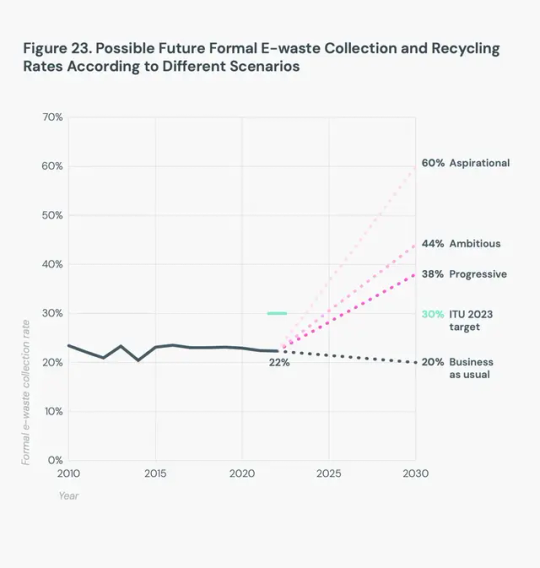
The complexity of e-waste, though, makes it expensive to process. As the chart above shows, even an ambitious scenario of a formal e-waste collection rate in 2030 is 44 percent. “There is no business case for companies to just collect e-waste and to make a profit out of this in a sustainable manner,” says Baldé. “They can only survive if there is legislation in place which is also compensating them.”
The report notes that 81 countries have e-waste policies on the books, and of those, 67 have provisions regarding extended producer responsibility, or EPR. This involves fees paid by manufacturers of EEE that would go toward e-waste management.
Of course, people could also stop throwing so many devices away in the first place, something right-to-repair advocates have spent years fighting for. Batteries, for instance, lose capacity after a certain number of charge cycles. If a phone can’t hold a charge all day anymore, customers should be able to swap in a new battery. “Manufacturers shouldn't be able to put artificial limitations on that ability,” says Elizabeth Chamberlain, director of sustainability at iFixit, which provides repair guides and tools. That includes limiting access to parts and documentation. “Repair is a harm-reduction strategy. It's not the be-all-end-all solution, but it's one of many things we need to do as a global society to slow down the rate at which we're demanding things of the planet.”
At the core of the e-waste crisis is the demand: A growing human population needs phones to communicate and fridges to keep food safe and heat pumps to stay comfortable indoors. So first and foremost we need high-quality products that don’t immediately break down, but also the right to repair when they do. And what absolutely can’t be fixed needs to move through a safe, robust e-waste recycling system. “We are consuming so much,” says Baldé, “we cannot really recycle our way out of the problem.”
26 notes
·
View notes
Text
Semikart: The Smart Way to Buy Electronic Components Online
In the fast-paced world of electronics and innovation, finding the right components at the right time is crucial for engineers, hobbyists, and manufacturers. Whether you're building a prototype, repairing a device, or developing a new product, access to high-quality parts is a necessity. That’s where Semikart steps in – offering a seamless, reliable, and smart way to buy electronic components online in India.

Why Semikart is the Go-To Platform for Electronics Enthusiasts
1. Extensive Product Range
At Semikart, you’ll find one of the best electronics components collections available online. From microcontrollers and sensors to connectors, capacitors, and semiconductors – the platform stocks over a million components from leading global brands. Whether you need standard parts or rare components, Semikart makes it easy to find what you’re looking for.
2. Genuine Electronic Spare Parts Online in India
One of the biggest concerns when purchasing electronic spare parts online in India is authenticity. Semikart addresses this by sourcing directly from trusted manufacturers and electronic components distributors in India. This ensures every product is 100% genuine, traceable, and ready for immediate use in your projects or production lines.
3. Serving Engineers and Innovators Across India
Based in the tech hub of Bangalore, Semikart caters to both professionals and students across the country. If you’re searching for electronic components online in Bangalore, Semikart offers quick delivery, competitive pricing, and strong local support – making it an ideal platform for the city’s vibrant engineering community.
4. Smart Features for Smarter Buying
Semikart is designed to make component sourcing efficient and hassle-free. Features like advanced search filters, real-time stock availability, BOM upload support, and instant quotes help engineers and procurement teams streamline their operations.
5. Support from Industry Experts
The Semikart team includes professionals with deep knowledge of the electronics industry. Whether you’re unsure about compatibility or need help with bulk orders, the customer support team is just a message or call away to assist you.
Trusted by Professionals Across Industries
From startups and academic institutions to large-scale manufacturers, Semikart has become a preferred choice for buying best electronics components online. Its commitment to quality, transparency, and fast delivery has earned the trust of thousands of customers across India.
#Buy online electronics components#cheap electronic components#Best Electronics Components#electronic spare parts online india#electronic components online shopping
0 notes
Text

Omron Relays Distributors
Omron relays distributors provide high-quality, reliable relays for various industrial and electronic applications. They ensure access to a broad range of products, offer expert technical support, guarantee timely delivery, and provide customized solutions to meet specific project needs.
0 notes
Text

Name: Moth
Model: MTH-9L
Manufacturer: Ceres Metals Industries
Intro Year: 3145
Class: Light Battlemech
Cost: 4.677 mn c-bills
Weight: 30 T
Top Speed: 97.2 kph
Jump Capacity: 240 meters
Quirks: difficult to maintain, no/minimal arms, nimble jumper
In the wake of the 6th Andurian War, the Strategios of the Capellan Confederation Armed Forces determined that there was a need for a new, low cost light mech to serve as a forward observer and harassment unit in their augmented companies. While the venerable Raven remained in service, its relatively low speed and expensive suite of electronics lead to a number of costly losses during the conquest of Wallacia. To that end, specifications for a new scout were sent out for bids- the new mech had to be cheap, difficult for Free Worlds League precision energy weapons to engage with, and capable of engaging and providing support for indirect fire elements of the CCAF at a variety of ranges. Unusually, despite Hellespont Industrials, the Confederation's more seasoned light manufacturer, submitting a bid in the form of the Sunfire, Ceres Metals Industries won the contract. Their design, initially named Project GOSSAMER, was delayed several times due to production shortfalls and the discovery of a Federated Suns spy ring operating at Ceres' design bureau. Eventually the mech began full production in 3145 as the Moth.
An outwardly radical design, Ceres managed to reduce the cost of their bid significantly through the use of a number of off the shelf parts and existing research prototypes. The mech's engine was a GM 180 extralight fusion power plant, originally designed for a prototype Vindicator before the VND-4L project opted for a larger 225 power plant instead, allowing the 30 ton mech to achieve ground speeds of up to 97 kph. While this speed was deemed unacceptable for the task at hand, the mech's principle designer, Dr. Oxana Ufimtsev, opted to equip the mech with a battery of Anderson jump jets and used a novel delta design for the main hull of the mech, with very low profile arms and wide, integrated control surfaces to give the mech an unusually high glide coefficient. Together, these systems allow the Moth to leap distances similar to those achievable by the Spider, despite the mech's far less powerful engine. The cost of this innovative design is a frame with extremely cumbersome access points and systems not immediately intuitive to most mechtechs, leading to increased maintenance costs and repair times. When deployed in augmented formations alongside aerospace assets, technicians are commonly cross trained on both the unit's fighters and Moths, as the two repair schedules have been found to be similar.
The production model MTH-9L Moth uses a Moscovia light PPC as its main armament, supported by a pair of Ceres Arms model JX small pulse lasers mounted in the two weapons nacels that comprise the design's arms. Additionally, the mech carries a Diverse Optics ER small laser in the left arm and an Apple Churchill TAG system in the left, imported from Hellespont's Sian facility. Clad in 6 tons of Ceres mk III Stealth Armor, the Moth is easily capable of withstanding light fire from enemy mechs while confounding longer range sensor returns. Unfortunately, to make room for the light PPC, Ceres opted to reduce the size and ammenities of the mech's cockpit, resulting in complaints from pilots assigned to the machine for long scouting patrols.
In combat, Moths are most typically used as long range harassment units, using their stealth armor and long jump range to maintain evade enemy fire as they opportunistically engage with their TAG and light PPC. As the fight progresses, some pilots may choose to engage in more active combat, allowing the indirect elements they're supporting to remove the majority of a target'a armor before attempting to destroy vulnerable exposed components with their small lasers
The first recorded combat involving a Moth occurred on Brisbane between elements of the First Victoria Rangers and a raiding force of the Concordat Commandos. Captain Curtis Bao deployed a lance of Moths to waylay the advance of a Taurian armored colum and allow for his own heavy units and combat vehicles to position themselves in foothills east of the TDF landing site. The light mechs caught the tank company and their mech escorts by surprise, outflanking the vehicles and engaging into their weaker side armor at long range with their PPCs while painting targets for Bao's LRM carriers and Thunderbolts. Eventually, the Commandos' mechs rallied and began to engage the stealthy light lance, forcing them to withdraw, however the action blunted the Taurian advance and allowed time for the Victoria Rangers to mount a successful defense of Brisbane's capital, Badwater. The surviving Moths then saw use as city fighters, their jumping capabilities allowing them to manuever easily though the urban fabric of Badwater while their X-pulse lasers let them to brutally engage Taurian infantry.
As a new design, very few variants or operators outside the Confederation have yet to be spotted. Beyond the CCAF, a few Capellan aligned mercenary commands have been allowed to officially purchase small numbers of the design, while the allied Magistracy of Canopus has managed to acquire a number of lances of the mech through unknown sources.
While their infiltration was discovered and rooted out before the full design was finalized, MIIO operatives did manage to steal plans for the early prototypes of the Moth, which the New Avalon Institute of Science used as a test bed for re-engineered laser designs and new SRM munitions. A small production run of the design, similar but without the Capellan stealth armor, was produced by Corean Enterprises at their Augusta plant, but the AFFS appears to have abandoned adding the mech to its TO&E.
Finally, several examples of the Moth were captured by forces loyal to Alaric Ward's Star League during fighting on New Earth. The Jade Falcon remnant present immediately saw use in the design as a heavier alternative to their light Ion Sparrows. A Clantech refit of the mech has been spotted using an ER large laser in place of the PPC and a quartet of small pulse lasers in the weapons nacels.
9 notes
·
View notes
Note
I have successfully managed to train my Rotom to not haunt my more expensive appliances but now they're having a hard time finding things they're comfortable possessing- any recommendations? The standard 5 forms are completely out of the question.
There are many Rotom-friendly toys and products out there! If burner phones are out of the question, electronic music boxes and cheap speakers are really fun to play with if your Rotom is particularly mischievous- as long as you don't mind the noise.
If you need something bigger, recycled vacuum cleaners or old cameras (as long as they have some kind of electrical component) can work too! You can get some of them for very cheap; they won't be good for human use but your Rotom will put them to good use for sure.
26 notes
·
View notes
Text
Repair Log: Big the Cat McDonald's Toy - Installment 1

ELECTRONICS
SYMPTOMS: doesn't turn on
LIKELY CAUSE: extremely dead battery
STEPS TAKEN: disassembled, identified component to replace (LR41 cell battery), identified corroded battery terminal
NEXT STEPS: procure replacement battery, clean/possibly resolder terminal
AESTHETICS
SYMPTOMS: scratched LCD screen cover, debris on underside of screen, wrinkled/worn cover
STEPS TAKEN: removed internal debris during disassembly
NEXT STEPS: attempt to buff scratches with toothpaste, attempt to reprint cover image
Details below.


Disassembly and diagnosis was easy because this is a really simple piece of hardware made cheap as a Happy Meal Toy. 4 case screws had proprietary heads but luckily the trihead screwdriver I have for Nintendo shit sort of worked on them.
I am crossing my fingers that once I buy a replacement battery and install it the thing will work good as new, because there's basically no other part in this that is in the slightest bit user-serviceable so if it doesnt work after that I'm shit out of luck. I'm optimistic though. It really doesn't seem like anything else on here should have a reason to be broken.
The AESTHETIC repair is probably going to be more complicated... because I don't think the image used as the skin for this exists anywhere else.
The render of Big is his official art in Sonic Heroes, but I can't find any other example of that background art ANYWHERE. It looks like Seaside Hill but I can't find any other examples of anything remotely like what's in this image. So all I have is this.

My thought was, if I could find the source image used as the skin for this or even the separate assets combined to make it, I could recreate it and then take it to a print shop to talk about sizing and get it reprinted. But that's starting to look impossible. I made a Reddit post in the hopes that someone will recognize it but so far it has one upvote and nothing else so I'm not holding my breath.
So, I think what I might actually do is just get a high quality scan of the toy I have and then try to digitally clean up the wrinkles and wear etc. I have a scanner so this should be doable.
I'll see how the scan comes out and go from there. If it's workable, I'll stop worrying about finding the original image.
So the to-do list is pretty much: replace battery, repair terminal, buff out scratches on screen, scan the cover, and if that scan is good enough, touch it up digitally and then get it professionally reprinted. 👍
#electronics repair#big the cat#big the cat happy meal toy#I enjoy taking things apart I had this in my hands for less than 10 minutes before it was on the table with its guts out
3 notes
·
View notes
Text
mmc magical girl AU lore dump:
The year is 20XX. The world is slowly approaching a post-scarcity utopia supported by unprecedented advances in technology and science. Quantum and classical physics have been united, asteroid mining has made electronic components cheap and abundant, medical technology guarantees a higher quality of life, and most recently, inorganic matter has been able to be converted into data and back.
Dr. Light and Dr. Wily developed a “robotic support system”, a type of protective suit integrated with incredibly advanced robotic tools for specific dangerous tasks, like rescues, handling hazardous material, or performing tasks in extreme environments. Light wants the suits to be used to help advance the frontiers of science, while Wily is more interested in its military applications despite large-scale conflicts being minimal in the present day. These support systems are integrated into the body to the point that removing them requires special equipment (think like an HEV suit), but the suits themselves are very powerful and cutting-edge. Light’s proposal to use them for scientific reasons is what ultimately wins out, and Wily is shunned for pushing for military use. Soon after this, Wily simply vanishes without a trace, which bothers Light but he can’t do anything about it.
At some point Light saves his oldest son, Blues, from dying of a heart condition with a suit prototype (LRSS-000) that regulates his heart rate and provides strength for his weakened body, but Blues had already accepted his death and doesn’t take having his body tampered with super well and ends up leaving home. Light creates generic support systems in the form of LRSS-001 and 002, proving the non-weaponized potential that the support system has, where his twin children Rock and Roll happily volunteer to demonstrate them with great success. Light then deploys LRSS-003 to 008 with handpicked candidates, qualified university graduates and trade employees, for use in scientific and industrial fields.
Wily shows up some years later and declares war on the world with his own version of the robotic support system, and a handful of 20-somethings that he’s coerced/bribed/blackmailed into piloting them, calling them “Bion Masters”. The suits are ridiculously powerful and there are far less military resources out there than in modern day due to the general state of peace in the world, so nothing can stop them. Rock and Roll both volunteer themselves to fight against Wily, but Light can’t bear to let either of them face danger after nearly losing Blues. Though Light’s Bion Masters try their best to fight back, they don’t have the same weaponized capabilities that Wily’s do and are slowly defeated and abducted one by one, each disappearance further weighing on Light’s conscience.
The most egregious act comes when Wily and Shadow Man break into the Light residence and kidnap Rock and Roll and their support systems, absolutely shattering Light’s will to fight back. Before he vanishes, Rock tells his father that he can’t give up here and urges him to resist Wily for everyone’s sake.
Light makes the difficult decision to weaponize the second series of support systems he’s been developing and seek out people who have enough courage to take on Wily’s forces. He finds the first seven users relatively quickly, but the last support system, 016, has so much dangerous potential that Light hesitates to find a user for it…
Light’s (Current) Bion Masters:
LRSS-009 “Concrete Man”
Good Point: Gets the job done Bad Point: Self-righteous Likes: Fulfilling work Dislikes: Laziness
The support system was designed for construction. In battle, he’s most effective at backline support, civilian rescue and damage mitigation, but has quite a lot of raw physical strength for defense. Concrete Shot can immobilize enemies.
LRSS-010 “Tornado Man”
Good Point: Confident Bad Point: Slacker Likes: New experiences Dislikes: Working
The support system was designed for weather management and mitigating storm damage. In battle, he acts as the leader and has quick mobility, focusing on clearing out large groups of enemies and moving victims of Wily’s assaults to safe areas. Tornado Blow can throw even heavy enemies into the air and damage them upon impact with the ground.
LRSS-011 “Splash Woman”
Good Point: Hard worker Bad Point: Moody Likes: Self-care Dislikes: Having her time wasted
The support system was designed for rescuing shipwreck survivors. In battle, she can fight up-close and excels at underwater combat and has small fish-like robots she can call on for extra support. Laser Trident can cut cleanly through metal and destroy robotic enemies.
LRSS-012 “Plug Man”
Good Point: Quick learner Bad Point: Over-exciteable Likes: Technology Dislikes: Boring tasks
The support system was designed for delicate but high-powered electronic manufacturing. In battle he’s a long-ranged fighter that can use both physical and electrical projectiles. Plug Ball can spread across surfaces and short-circuit any machines that aren’t hermetically sealed.
LRSS-013 “Jewel Man” Good Point: Stylish Bad Point: Self-Centered Likes: Interesting things Dislikes: Being rejected
The support system was designed for jewel mining. In battle, he’s a very fast and up-close brawler that can even claw metal apart. Jewel Satellite can protect him from energy shots and damage enemies on contact.
LRSS-014 “Hornet Man” Good Point: Compassionate Bad Point: Pushover Likes: Nature Dislikes: Selfishness
The support system was designed for botany and environmental science work. In battle, he’s primarily a backline fighter that provides remote support. Hornet Chaser can pursue enemies and pierce through metal with lasers.
LRSS-015 “Magma Man”
Good Point: Calm Bad Point: A little dense Likes: Traveling Dislikes: Staying indoors
The support system was designed for work in volcanic environments. In battle, he’s a very slow but powerful frontline fighter. Magma Bazooka can melt through metal armor with direct shots.
LRSS-016 “Galaxy Man” Good Point: Creative Bad Point: No people-skills Likes: Science Dislikes: Strangers
The support system was designed for performing spacewalks and maintenance on space stations and satellites. In battle, they’re highly mobile and can hit devastatingly hard, but are themself fragile. Black Hole Bomb can suck up pretty much anything that isn’t tied down or attached to the ground, so it can destroy huge groups of enemies at once.
...That's everything I have formally written down, at least, but I've also made a lot of offhand remarks when brainstorming for this.







44 notes
·
View notes